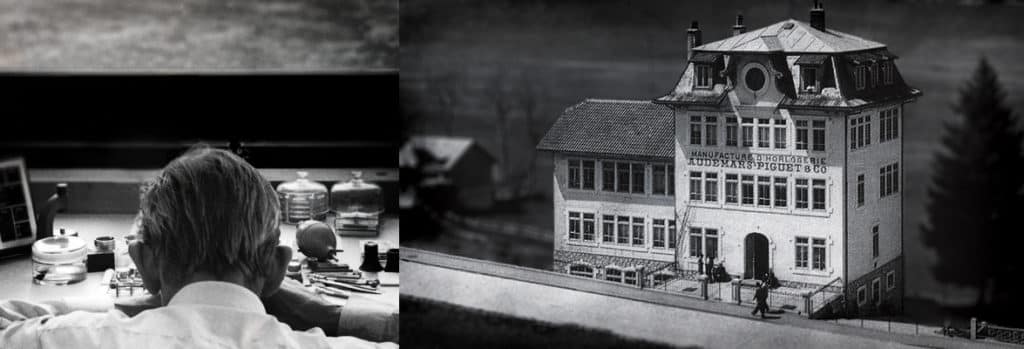Audemars Piguet is manufacturer of ultra-luxury Swiss watches and is celebrated for its precise movements and exquisite, opulent designs. It was founded in 1875 in the village of Le Brassus, at the heart of the historical haven of complicated horology named the Vallée de Joux.
Since the beginning, the brand has taken immense pride in manufacturing some of their brilliant time pieces in this village. Currently, they have acquired two more production sites, one specializing in the development of complex mechanisms in Le Locle, named Audemars Piguet Renaud et Papi, (APRP) and a case-making company based in Meyrin-Geneva, Centror.

The company was started by two visionaries, Jules Louis Audemars and Edward Auguste Piguet, who were ambitious to develop and craft timepieces equipped with complex mechanisms. They established their workshops in Le Brassus, in Switzerland’s Vallée de Joux, the cradle of fine watchmaking, and Audemars Piguet was born. Even today, all their watches are produced in-house using traditional old-fashioned techniques, and every piece is painstakingly created in a non-automated process.

Since 1875, the company has written some of the finest chapters in the history of haute horlogerie, including a number of world firsts. After producing the world’s thinnest watch in 1946 and their first wristwatch with a perpetual calendar in 1957, they launched one of the most iconic watch designs of all time in 1972: the Royal Oak – the first luxury watch to be made of stainless steel which is widely recognized as one of the most important innovations in watchmaking.
The Royal Oak Line
When the Royal Oak, now a cult watch with passionate fans and committed collectors, first saw the light of day nearly forty years ago, it transformed the world of watchmaking: and also transfigured Audemars Piguet. In 1971, when the in-house designer Gerald Genta sketched what would become a world-famous watch, he may not have been aware that the octagon is an age-old symbol of rebirth and resurrection. Yet, once unveiled in 1972, the Royal Oak had precisely that effect.

For Georges Golay, president of Audemars Piguet from 1966 to 1987, launching the Royal Oak was a daring move. The watch emobodied a totally new concept, namely a model that was simultaneously sporty and luxurious. It was made of steel yet crafted with so much concern for perfection that it cost more than an upscale gold watch.
Equipped with a caliber 2121, the world’s slimmest automatic movement with a date window, it was barely eight millimeters thick and weighed no more than one hundred grams. Its 21-karat gold oscillating weight justified the launch slogan: “Body of steel, heart of gold”. Its watertight case received a level of finish previously reserved for precious metals.
The metal strap, which had to be assembled and finished by hand, was notable for the way it was incorporated into the case, for its elegant curve resulting from links and studs of decreasing size, and for its flexibility. The eight hexagonal screw heads of white gold, visible on the bezel, underscored the originality and modernity of the watch. The engine-turned decoration on the dial featured a blue, grid-like “Tapestry” pattern specially created for it by the great dial-maker Roland Tille, further breaking convention.

That first Royal Oak, initially produced in a series of one thousand, also represented an industrial challenge for Audemars Piguet. Not only had the firm never produced more than six thousand watches per year, its watchmakers had never worked with steel. Unveiled at the Basel trade fair, the Royal Oak sparkled admiration, stupor, and skepticism among professionals.
Yet the paradox on which it was based – the attempt to combine simplicity with luxury, casualness with refinement, and modesty with perfection – met with instant enthusiasm from lovers of fine timepieces. It turned out to be a great commercial success. Which meant that Audemars Piguet had to revitalize its traditional methods on a grand new scale – with the success of this steel octagon, the firm was reborn as a modern manufacturer in which rigor, precision, and quality control were required at every stage of production.

Why the name “Royal Oak”? First of all, it was the name given to a historic tree, the large oak in which English King Charles II hid in order to avoid capture by Cromwell’s army after the battle of Worcester in 1651. Following the restoration of the English monarchy, the tree that saved the King’s life became an important political symbol: between 1796 and 1914, no fewer than four British warships were christened The Royal Oak.
Audemars Piguet adopted this name to evoke not just royal prestige but also noble longevity, because it transpired that the oaken hull of the second Royal Oak was lined with steel. The watch, whose shape also evokes a ship’s bolted porthole (and which Genta said was inspired by the perfectly watertight window of diving helmet), therefore brought with it a fresh breath of ocean breeze, sea foam, and whitecaps.

Audemars Piguet’s revolutionary watch also brought new, unexpected life to the Joux Valley. It challenged traditions and stimulated imaginations. In the subsequent four decades, the Royal Oak line has branched in several directions and blossomed into hundreds of different models. Since its birth, the Royal Oak has adopted almost every complication, has been dressed in brushed gold, platinum, tantalum, titanium, alacrite and forged carbon, has been undressed in skeleton versions, has been endowed with straps of leather and Kevlar, and has been metamorphosed into a diamond – studded Lady Royal Oak as well as an even sportier model – the Royal Oak Offshore – which is larger due to a second case shielding it from magnetic field.
The Royal Oak Line development:
- 1987 A skeleton Royal Oak with perpetual calendar and self-winding mechanism flaunted its technical prowess before the delighted eyes of mechanical enthusiasts.
- 1992 The Royal Oaks’ reputation.
- 1998 Audemars Piguet’s watchmakers turned out an automatic Royal Oak Chronograph with date, the thinnest self-winding chronograph ever produced, which to this day remains one of the line’s leading commercial successes.

In the same year, Audemars Piguet decided to place an automatic grand complication movement in a Royal Oak case.
- 2002 The thirtieth anniversary of the Royal Oak line was celebrated by unveiling a magnificent, totally original and futuristic model, the Royal Oak Concept.
- 2004 Barely two years after the Concept, there appeared another extraordinary limited edition watch, the Royal Oak Tourbillon.
Brand Codes
Proud of its long history, Audemars Piguet nurtures its traditions. It does so first of all by perpetuating demanding standards of training for budding watchmakers. In this spirit of respect for high standards, constant self-improvement, and love of work well done, Audemars Piguet hosts some fifteen trainees, in different specialties, at its in-house training center, where they acquire the basics of the trade.

The determination to pass on the finest traditions, which was the original source and longterm guarantee of the reputation of Joux Valley watchmakers, is still a major concern at Audemars Piguet. There would not be much point in keeping one eye on the future if the house did not simultaneously look to its long history, without which it would sacrifice its roots, values, and reasons for making certain decisions.
Audemars Piguet is also famous for its strong and masculine designs. It stems love of constant progress, continual advancement and eternal improvement. But what is the source of this dynamism, this conviction, this daring, that occasionally leads down dangerous paths? Perhaps it goes back to the temperament of the two founders, who both abandoned secure prospects to launch a risky venture.

This temperament, passed on from generation to generation, has spurred the Le Brassus watchmakers to seek the unknown, to wager on originality, for over a century and a half. Whether it concerns the visual appearance of a watch, the harmony of shapes and materials, or the conception and design of timekeeping mechanisms, the firm’s well-known creativity has been crowned by a series of firsts.
“What is important is not the metal or jewels, it’s to take risks, and through the work of designers, engineers, technicians and watchmakers, you transform it into something that is more precious than gold. A good example is the Royal Oak. When we launched it, it was in the middle of one of the worst crisis the watch industry ever went through, and, at the time, all the watches in our category were in precious metals and were round or oval, so to launch a watch in steel with sharp angles and visible screws at the same price as a Patek Calatrava or the double of a Rolex was a really big risk.” – said Olivier Audemars, the great-grandson of Edward Auguste Piguet.

In addition to innovations that target the case, Audemars Piguet has employed materials in its movements that are as unusual as they are luxurious and beautiful. An openwork design often allows the mechanism to be admired, for it includes hard, natural stones such as rutilated quartz, moss agate, and chalcedony, of which some bottom plates are made, representing yet another watchmaking revolution in a word where technical secrets are usually well-kept.
Their love of constant improvement has always been matched by a love of the finest standards of quality. In addition to the quality and originality of the movements themselves, this quest for excellence at Audemars Piguet has always concerned the finish and decoration of every part of the watch, whether visible or invisible, external or internal. Excellence from start to finish means the multiple polishing and burnishing of a case, the meticulous setting of stones in jewelry models, and the extreme attention paid to the elegance, reliability, and sturdiness of leather or metal straps.

As the progressive timepiece manufacturer, they have been striving not only to reach excellence in the watch making process but also seeking out methods to aid sustainability effort to protect our planet. Since 1992, the twentieth anniversary of the unveiling of the Royal Oak, the watch house established a foundation that has actively participated in conservation and preservation of the world’s forests.
In addition to environmental protection programs, the foundation sponsors educational projects designed to make adults and young people aware of the need to safeguard the environmental in general.
Also, the brand has implemented “green” technologies in diverse aspects of their production. The manufacturer des Forges, operated by Audemars Piguet, is the only industrial building in Switzerland to attain the Minergie – “eco-status” to conduct an environmental audit of the company with a view of optimizing use of energy, water and other raw materials, as well as improving management of transportation, waste disposal, and has the exclusive use of certified hydraulic electricity.
The foundation’s substantial annual budget is financed by every watch sold. Thus, everyone who purchases an Audemars Piguet watch is helping to bring that goal a little closer.
Thus, in a nutshell, some of the core values of the brand can be summed up as follows:
- Precision
- Innovation
- Craftmanship
- Masculinity
- Heritage
- Royalty






